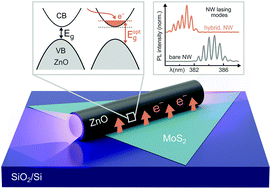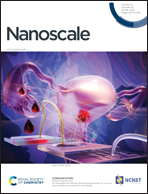Tuning nanowire lasers via hybridization with two-dimensional materials†
Abstract
Mixed-dimensional hybrid structures have recently gained increasing attention as promising building blocks for novel electronic and optoelectronic devices. In this context, hybridization of semiconductor nanowires with two-dimensional materials could offer new ways to control and modulate lasing at the nanoscale. In this work, we deterministically fabricate hybrid mixed-dimensional heterostructures composed of ZnO nanowires and MoS2 monolayers with micrometer control over their relative position. First, we show that our deterministic fabrication method does not degrade the optical properties of the ZnO nanowires. Second, we demonstrate that the lasing wavelength of ZnO nanowires can be tuned by several nanometers by hybridization with CVD-grown MoS2 monolayers. We assign this spectral shift of the lasing modes to an efficient carrier transfer at the heterointerface and the subsequent increase of the optical band gap in ZnO (Moss–Burstein effect).

- This article is part of the themed collection: Nanoscale 2022 Emerging Investigators


 Please wait while we load your content...
Please wait while we load your content...